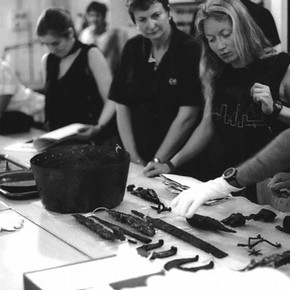Conservation Journal
Autumn 2000 Issue 36
Postgraduate Training in Conservation at the Hungarian National Museum

Figure 1. RCA/V&A students vist the metals conservation workshop of the Hungarian National Museum's MA course. Photography by Andrew Wingham (click image for larger version)
In June 2000, tutors and students from RCA/V&A Conservation travelled to Budapest, Hungary, for a five-day study trip. The aim was to visit several of the city's museums and art galleries, meeting museum staff and conservators and to build up a picture of the conservation profession in this country. Hungary's communist administration ended in 1991and naturally this has meant changes for the country's museums, along with the rest of its infrastructure. Of particular interest was a visit to the MA programme run by the Hungarian National Museum in conjunction with the Hungarian Academy of Fine Arts.
Established in 1974, and currently run by Dr Ágnes Tímár-Balázsy, the five-year state-funded programme has similarities to RCA/V&A Conservation but with some significant differences in their approach. Students are drawn from a wide background, and around half are already in full-time employment. There are several entry routes, including a career-entry course, also run by the Hungarian National Museum, a mid-career course run by the National Library, a two years' previous experience or a week-long entrance examination.
Like RCA/V&A Conservation, students opt to specialise on starting the course, and choose from five areas, including siliceous objects and stained glass; metal and goldsmith objects; wooden objects and furniture; paper and leather objects and textiles and leather objects. However, all students must follow a general core curriculum for the first three years, training in all materials, before embarking on their specialism for the remaining two years.
Science is an important part of the teaching, and two of the Hungarian National Museum's conservation scientists, Márta Járó and Klara Török tutor students and assist with research. Two laboratories are used for conservation science; one for wet chemistry, where the use of spot tests and stains and thin layer chromatography is taught and the other for microscopy, equipped with a videomicroscope and optical and fluorescence microscopes. Márta Járó has recently been conducting research into metal threads1 and teaches inorganic conservation science. Klara Török, an organic chemist, specialises in pigments and binders. She has recently been involved in a collaboration with the Textile Conservation Centre in the UK investigating paint cross-sections on a selection of banners and flags.
Indeed, it is through collaborations, as often happens in the UK, that the conservation scientists carry out much of their analysis. Links with various universities in Budapest, allow scientists access to most of the techniques used for materials characterisation, such as scanning electron microscopy (SEM), electron probe microanalysis (EPMA), x-ray diffraction (XRD), high performance liquid chromatography (HPLC), gas chromatography, mass spectrometry and Fourier-transform infra-red spectroscopy (FTIR).
In terms of practical conservation, students may work on objects from the Hungarian National Museum or, if they are already employed, from their own museum. Prior to object conservation, all students undertake lengthy technological studies involving the production of replicas. These may be of ceramics, leather objects such as book bindings and bags, paper and three-dimensional paper objects such as boxes and fans, and metal objects such as jewellery and foundry use. These skills are further expanded when the students pursue their specialism, with impressive results. This aspect of practical work differs from the approach usually followed in the UK. Other parts of the course, such as documentation and presenting seminars, were more familiar to us.
This course is a testament to the commitment and enthusiasm of Dr Tímár-Balázsy and her colleagues that, despite often non-ideal conditions, the course has produced over 200 graduates to date.
References
Autumn 2000 Issue 36
- Editorial - Science Meets Art in South Kensington
- Conservation Award
- Creating Sparks
- Defining Conservation Science: Training and the Profession
- Postgraduate Training in Conservation at the Hungarian National Museum
- Science and Art: Separated by a Common Language?
- Science in the Galleries
- Topographical Studies in the Conservation of Statuary Materials
- Printer Friendly Version